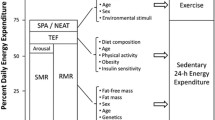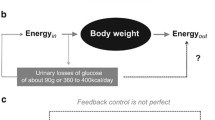Abstract
Energy homeostasis is the balance between energy intake and energy expenditure. Assessment of energy intake is unreliable, especially in obese individuals. On the contrary it is possible to assess energy expenditure by means of different techniques. In this review, the contributions of indirect calorimetry to its assessment and to the comprehension of the pathogenic mechanisms of obesity and diabetes mellitus are discussed. Knowledge regarding energy expenditure and its components (basal metabolic rate, food-induced thermogenesis, expenditure related to physical activity), obtained in obese individuals by means of indirect calorimetry, is summarized. The effects of dietetic manipulation of the relative fractions of macronutrients (fat, carbohydrate and protein) and fiber intake on energy expenditure are described with implications regarding the pathogenesis of obesity. Besides environmental factors, energy expenditure is strongly influenced by inherited features. The application of indirect calorimetry to study recently discovered polymorphisms of genes strongly related to energy expenditure in humans is also summarized. The role of indirect calorimetry in the identification of the glucose metabolic pathways (oxidative and non-oxidative) affected in the insulin resistance syndrome is also described. Indirect calorimetry has been useful in realizing that the alterations typical of insulin resistance are reproducible in vivo in healthy humans, increasing the availability of free fatty acids. In fact, indirect calorimetry contributed to understanding the in vivo mechanisms of substrate competition, which was hypotzesized more than forty years ago. In this field of application, the identification of simple (non-invasive and inexpensive) markers of insulin resistance is urgent for primary and secondary prevention of these diseases with high morbidity and mortality. The postabsorptive assessment of resting energy expenditure and macronutrient partitioning in fuel metabolism may be helpful and is discussed with advantages and limitations. The treatment of multifactorial diseases will probably require the use of poly-therapeutic interventions. In fact, drugs that act purely on one pathogenic factor of these diseases frequently fail. To better design strategic therapeutic approaches for each patient, to achieve significant long-term efficacy in the treatment of these diseases and to prevent their complications, indirect calorimetry has to be considered a landmark of quality control for nutritional support.
Similar content being viewed by others
Author information
Authors and Affiliations
Rights and permissions
About this article
Cite this article
Perseghin, G. Pathogenesis of obesity and diabetes mellitus: insights provided by indirect calorimetry in humans. Acta Diabetol 38, 7–21 (2001). https://doi.org/10.1007/s005920170023
Issue Date:
DOI: https://doi.org/10.1007/s005920170023




